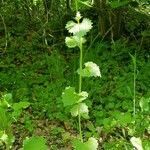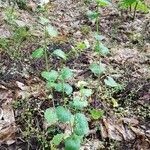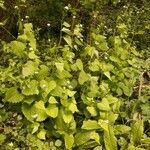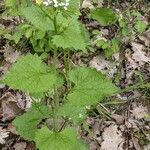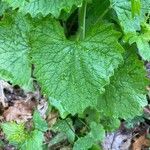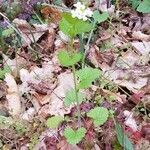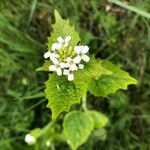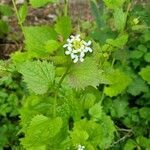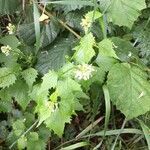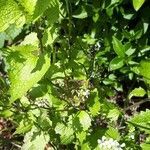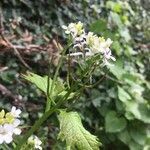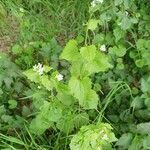Stems simple or branched distally, (1.5-)3-9(-13) dm; glabrous or pilose basally, trichomes to 1.5 mm. Basal leaves: petiole 3-16(-22) cm; blade reniform or cordate, (6-)15-88(-118) mm wide (shorter in length), surfaces glabrous or pilose. Cauline leaves: petiole shorter than basal; blade ovate, cordate, or deltate, to 15 × 15 cm, base cordate or truncate, margins acutely to obtusely toothed, apex acute. Racemes several-flowered. Fruiting pedicels terete, (2-)3-10(-15) mm. Flowers: sepals (2-)2.5-3.5(-4.5) × 0.7-1.5 mm; petals (2.5-)4-8 (-9) × (1.5-)2-3(-3.5) mm, base attenuate to clawlike; filaments 2-3.5(-4.5) mm; anthers oblong, 0.7-1 mm. Fruits divaricate-ascending, subtorulose, quadrangular or subterete, (2-)3-7(-8) cm × 1.2-2.5 mm; style (0.2-) 1-2(-3) mm. Seeds dark brown or black, narrowly oblong, 2-4.5 × 0.7-2 mm. 2n = 42.
Biennial herb. Stem erect, sparsely hairy at base, becoming glabrous above, 40-70 cm tall. Lvs thin, glabrous above, with scattered hairs on veins beneath. Rosette and lower stem lvs reniform to ovate, cordate, obtuse to subacute, sinuate-dentate, (1.5)-3-8 × (2)-3.5-8 cm; petiole c. 2× length of lamina. Stem lvs similar, becoming triangular, truncate, coarsely dentate; petiole < lamina. Racemes 10-30 cm long at fruiting. Pedicels c. 5 mm long, slender at flowering, stout at fruiting. Sepals glabrous, ovate, 2-3 mm long. Petals white, 3-4.5 mm long. Siliques glabrous, spreading or slightly ascending, linear-cylindric, weakly torulose, (25)-35-50 × 1.5 mm; style 0.5 mm long. Seeds brown, finely longitudinally striate, 3-3.5 mm long.
A cabbage family herb. It is a biennial plant as it takes 2 years to complete its life cycle. It grows 1 m high and 40 cm across. It gives off a strong smell of garlic. The leaves are bright green and the lower leaves are kidney shaped. The upper leaves are oval. The edges are wavy and can have rounded teeth. They are 5-15 cm across. The flowers are small and white. They are 5-10 mm across. They are in clusters at the tips of the stems and at the leaf bases. The fruit are slender pods 5 cm long. They are cylinder shaped and upright. There are many very small seeds.
Biennial to 1 m, simple or little-branched, glabrous or with a few simple hairs; lower lvs reniform, the others deltoid, 3–6 cm long and wide, acute, coarsely toothed; pet 5–6 mm; mature pedicels stout, 5 mm; frs widely divergent, 4–6 cm; seeds black, 3 mm; 2n=42. Native of Europe, now found as a weed in gardens and moist woods throughout most of our range. May, June. (A. alliaria; A. officinalis)
